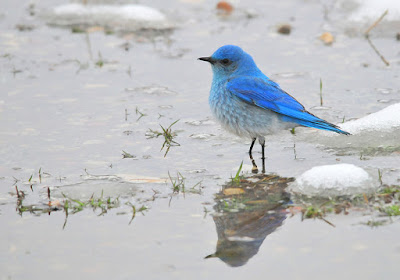 |
| Mountain Bluebird / Photo by Tom Koerner/USFWS |
- The AOS released the third batch of taxonomic proposals for 2017 (pdf). Highlights include splits of the Nashville Warbler and Brown Creeper and a lump of Thayer's and Iceland Gulls. See also discussion at the ABA Blog. If Nashville Warbler is split, I hope the eastern population gets a better name than "Rusty-capped Warbler" since the reddish spot is one of the bird's least-visible features.
- Satellite imagery shows migratory shorebird habitat loss in California's Sacramento Valley because of drought and reduced seasonal flooding.
- Landscaping with native plants is better for birds since birds feed their young with the insects that are adapted to native plants.
- Birds are able to stand on ice without freezing because of a heat exchange that warms blood as it returns from their feet and because their feet have fewer nerves and muscles to get frostbite.
- The US Fish and Wildlife Service is running a live web cam at a Greater Sage-Grouse lek in Oregon. While the web cam runs all day, viewers are most likely to see grouse activity during the early morning hours (presumably Pacific time).
- Look for migrating Turkey Vultures as they return to points further north.
- Birds have blind spots in front of their heads, and the size of the blind spot seems related to beak size.
- Birding Frontiers: Female Common Eider plumages in the western Atlantic
- Birding Dude: Jamaica Bay West Pond Restoration Update - The Breach is Closed
- 10,000 Birds: In defence of museum collections
- Outside My Window: I’m Moving Northward
- Mia McPherson's On The Wing Photography: Spring Means Nesting Birds and Chicks – Please Give Them Space
- Corvid Research: Everything you want to know about crow nests
- The Rattling Crow: Woodpigeons calls and displays
- Feathered Photography: Can’t We Go Any Faster, Dad?
- Backyard and Beyond: Accipiter gentilis II
- Snapshots of Nature: A Loony Evening
- The Trump administration issued an executive order this week to start a rollback of various Obama administration climate initiative, including the Clean Power Plan. Issuing new regulations that can pass legal challenges could take some time. A White House official who briefed reporters on the order appeared confused about climate science.
- The ending of federal leadership on climate change means that cities and states will have to retake the lead.
- Scott Pruitt rejected the conclusions of EPA scientists and decided not to ban the pesticide chlorpyrifos. The pesticide poses a threat to people, especially children exposed to it, and also to 100 species of birds.
- While the Trump administration gave its approval for the Keystone XL pipeline, construction still faces legal hurdles and likely protests.
- Meanwhile, demonstrators in Indonesia are fighting the planned construction of a coal plant in Batang.
- Sweden, Germany, and France so far are the only EU countries fulfilling their Paris climate goals; most others have left loopholes in their new greenhouse gas policies.
- Climate change is already affecting the ranges of many plant and animal species, and that will likely include invasive plants.
- Climate change may be intensifying China’s smog problem because of climate-induced changes in weather patterns.
- Logging to stop the spread of invasive Southern Pine Beetles in Connecticut will have the creation of young forest habitat as a side effect.
- The West Indian Manatee has been downlisted from endangered to threatened on the basis of population stabilization and habitat improvements.
- A state appeals court ruled that Lacey Township can build a road on its section of the Barnegat Branch rail trail since the township never designated the former rail line as preserved open space.
- The Cheerios seed giveaway was well intentioned but could have been better designed.







